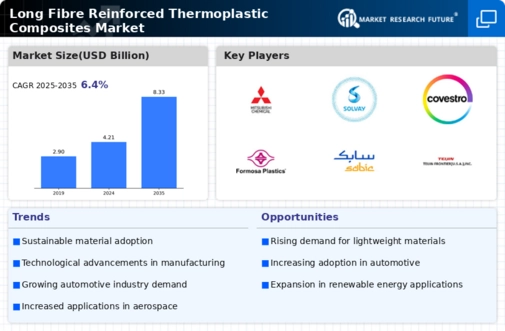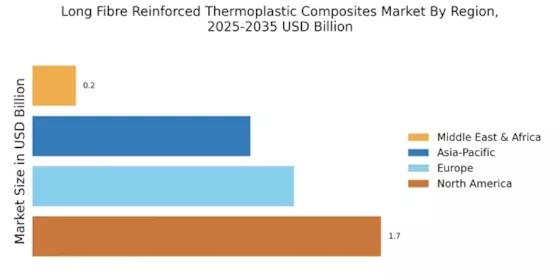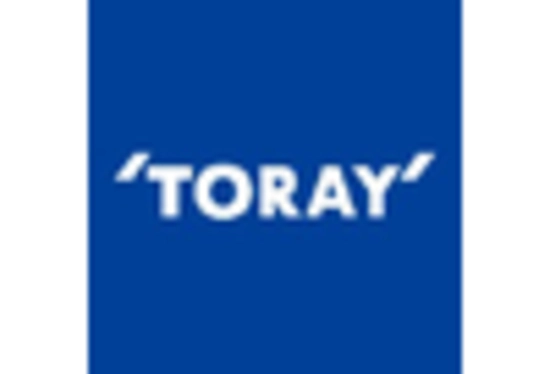The Long Fibre Reinforced Thermoplastic Composites Market is currently characterized by a dynamic competitive landscape, driven by increasing demand for lightweight materials across various industries, including automotive, aerospace, and consumer goods. Key players such as BASF SE (Germany), SABIC (Saudi Arabia), and Solvay SA (Belgium) are strategically positioning themselves through innovation and partnerships. BASF SE (Germany) has focused on enhancing its product portfolio with advanced composite materials, while SABIC (Saudi Arabia) emphasizes sustainability in its operations, aiming to reduce carbon footprints. Solvay SA (Belgium) is actively pursuing digital transformation initiatives to optimize its manufacturing processes, thereby enhancing efficiency and reducing costs. Collectively, these strategies contribute to a competitive environment that is increasingly centered around technological advancement and sustainability.
In terms of business tactics, companies are localizing manufacturing to better serve regional markets and optimize supply chains. The market structure appears moderately fragmented, with several key players exerting influence over specific segments. This fragmentation allows for niche players to emerge, yet the collective strength of major companies like Covestro AG (Germany) and DSM (Netherlands) ensures that competition remains robust. Covestro AG (Germany) has been particularly focused on supply chain optimization, which is crucial in maintaining competitive pricing and ensuring timely delivery of products.
In August 2025, Toray Industries, Inc. (Japan) announced a strategic partnership with a leading automotive manufacturer to develop next-generation long fibre reinforced thermoplastic composites. This collaboration is expected to enhance the performance characteristics of automotive components, aligning with the industry's shift towards lightweight materials. The strategic importance of this partnership lies in Toray's ability to leverage its advanced material science capabilities, potentially setting new benchmarks in the automotive sector.
In September 2025, Teijin Limited (Japan) launched a new line of long fibre reinforced thermoplastic composites specifically designed for the aerospace industry. This product line aims to meet the stringent requirements for weight reduction and performance in aerospace applications. The introduction of this innovative product underscores Teijin's commitment to expanding its footprint in high-performance sectors, which could significantly enhance its market share and competitive positioning.
In October 2025, Celanese Corporation (United States) revealed plans to invest in a new manufacturing facility dedicated to long fibre reinforced thermoplastic composites in North America. This investment is anticipated to bolster local production capabilities and reduce lead times for customers. The strategic significance of this move lies in Celanese's intent to strengthen its supply chain resilience while catering to the growing demand for advanced composites in the region.
As of October 2025, the competitive trends within the Long Fibre Reinforced Thermoplastic Composites Market are increasingly influenced by digitalization, sustainability, and the integration of artificial intelligence. Strategic alliances are becoming more prevalent, as companies recognize the value of collaboration in driving innovation and enhancing product offerings. Looking ahead, it is likely that competitive differentiation will evolve from traditional price-based competition to a focus on innovation, technological advancements, and supply chain reliability, thereby reshaping the market landscape.


















Leave a Comment